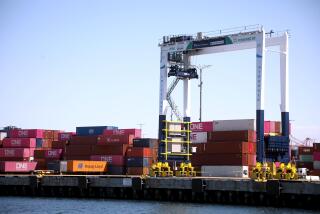Hydrogen fuel could revolutionize airlines. Here’s how that could look
- Share via
Environmentally conscious travelers are in a quandary.
Global airline travel has grown over the decades, and with it, so have the industry’s carbon emissions.
Not everyone has the time to use more eco-friendly travel methods, like Swedish climate activist Greta Thunberg’s famous two-week voyage last year across the Atlantic Ocean on a zero-emissions sailboat.
But can the airline industry shrink its carbon footprint, which currently makes up 3% of all U.S. greenhouse gas emissions? The answer hinges on development of alternative fuels.
Last month, European aircraft maker Airbus announced it would evaluate three concept planes, each of which would be primarily powered by hydrogen. The goal is to figure out an aircraft design and manufacturing process so the hydrogen plane could potentially enter commercial service by 2035.
“Alternative fuels are the key to unlocking air transportation emissions,” said Megan Ryerson, the University of Pennsylvania’s UPS chair of transportation and an associate professor of city and regional planning and electrical and systems engineering. “Without them, we either have to stop flying or make drastic cuts in other sectors.”
There’s a lot researchers like about hydrogen. For one, it’s incredibly energy dense — more so than jet fuel, and much more than current battery technology. It’s also plentiful and burns cleanly, producing no carbon dioxide or carbon monoxide.
“Hydrogen is an amazing fuel,” said Gozdem Kilaz, an associate professor at Purdue University’s school of engineering technology. “It is theoretically a wonderful fuel option.”
But there are technical and logistical challenges that need to be resolved.
As demonstrated by the 1937 Hindenburg airship disaster, the fuel is extremely flammable. And figuring out where in the plane to put it requires a brand-new aircraft design. Hydrogen is a gas at room temperature, so to store the fuel as a liquid — which takes up less space — hydrogen tanks would have to be more sturdy and high-pressure than those that hold traditional jet fuel. Such tanks would be too heavy to fit in a plane’s wings, where jet fuel is currently stored.
That means other parts of the aircraft will probably be repurposed for storage, said Amanda Simpson, vice president for research and technology at Airbus Americas.
The other major issue: a lack of infrastructure. Unlike with jet fuel, there are no established pipelines or facilities at airports where planes could fill up. Creating that infrastructure would be expensive and would probably require buy-in from governments and industry players across the globe.
If single-aisle passenger planes worldwide were to run on hydrogen, airlines would buy about $320 billion of the fuel per year, said Paul Eremenko, chief executive of fuel logistics firm Universal Hydrogen Co. That’s a lot, he said, but it still doesn’t necessarily justify building out such an expensive infrastructure system.
That’s where his company would step in. Universal Hydrogen, which plans to establish headquarters in Los Angeles, is developing a type of capsule technology that would enable either liquefied or gaseous hydrogen to be shipped using the existing freight shipping system and delivered to airports to fuel up planes.
Eremenko described the company’s business model as similar to that of companies that make Keurig or Nespresso drink pods. The company doesn’t want to produce hydrogen or build fleets of hydrogen-fueled planes. Rather, it wants to license the capsule technology and connect those two ends of the hydrogen supply chain.
The start-up plans to begin service with regional airlines in 2024 and has so far focused on design of the supply system and some prototyping. It does not yet have confirmed supply contracts.
Over the next year, Universal Hydrogen plans to do a full-scale demonstration of its capsules and work on its aircraft conversion kit, which would help airlines convert their planes to run on hydrogen. The company plans to offer to subsidize the conversion in exchange for a long-term contract, said Eremenko, who previously worked at Airbus and aerospace conglomerate United Technologies.
“We are relying just on the sheer economics of hydrogen,” he said. “The reception from the operators has been very positive.”
On the manufacturing side, the challenge is to figure out how hydrogen best powers a plane.
In one of Airbus’ concepts, a plane with a turbofan engine would be powered by hydrogen fuel and be able to carry 120 to 200 passengers for more than 2,300 miles. In another idea, more suitable for short-range trips, a turboprop engine powered by hydrogen would be used.
Airbus’ investment to develop a hydrogen aircraft will be “sizable,” Simpson said. Although Airbus hasn’t tabulated an exact cost, Simpson said it could be in the millions of dollars. Engines are a big part of the investment, but so are the systems for handling fuel and getting it aboard an aircraft. Investments would also be made by governments, research institutes and industry players around the world, Simpson said.
The company plans to spend the next five years focused on technology development before reaching the design and manufacturing stage.
Airbus is also looking at the potential emissions from burning hydrogen.
Water vapor is one. But there also could be a “trace amount” of atmosphere-warming nitrous oxide, Simpson said, though it would be “extremely small” compared with the amount from conventional jet fuel propulsion.
The final decision on whether a hydrogen plane is ready for commercial service will “come down to the economics and the supportability and, quite frankly, our customer interest,” Simpson said. “Showing the technology is feasible and that it’s economical is key.”
Hydrogen is just one option Airbus is considering. The company is also looking at hybrid hydrogen-electric planes and all-electric planes. It has made some inroads on the all-electric front: In 2015, a two-seat Airbus electric plane crossed the English Channel.
But experts say limitations in battery technology make electric planes less feasible for conventional air travel. The most important consideration for a plane is weight, and without a major breakthrough in battery technology, jet fuel is still lighter and provides more energy.
Another option is biojet — that is, a subset of biofuels that mimics the behavior of conventional jet fuel.
Unlike with hydrogen or electrification, biojet could be used in current planes largely as they are, without requiring any engine changes or major shakeups to fuel infrastructure.
“The burden of switching over doesn’t lie with the airline industry,” said Tonghun Lee, a professor in the department of mechanical science and engineering at the University of Illinois at Urbana-Champaign who researches alternative clean fuels. “That’s why I think it’s a more feasible solution.”
But biojet is expensive. And burning it still spews carbon into the air, though its net carbon emissions are lower because the first step in producing the fuel is to grow organic matter, such as plants, that absorb carbon dioxide.
It also can’t stand alone yet. ASTM, an international standards organization, has approved only blends — biojet mixed with conventional jet fuel — in order to meet performance requirements and safety concerns. Even the highest-percentage blend is only half biojet.
More collaboration between government, businesses and academia would be needed to effectively produce biojet in mass quantities in the future, Purdue’s Kilaz said.
While these fuels are developed, airlines will have to decide whether they will adopt them. After all, many are reeling from a steep loss in revenue caused by the COVID-19 pandemic, and buying new aircraft is a pricey proposition, especially if airlines have older aircraft in storage.
“Airlines aren’t necessarily motivated by the environment,” said Ryerson of the University of Pennsylvania. “If making profit and reducing their greenhouse gas emissions works together, they will invest in reducing greenhouse gas emissions. But if those two things are not tied, they will favor making a profit.”
More to Read
Inside the business of entertainment
The Wide Shot brings you news, analysis and insights on everything from streaming wars to production — and what it all means for the future.
You may occasionally receive promotional content from the Los Angeles Times.











